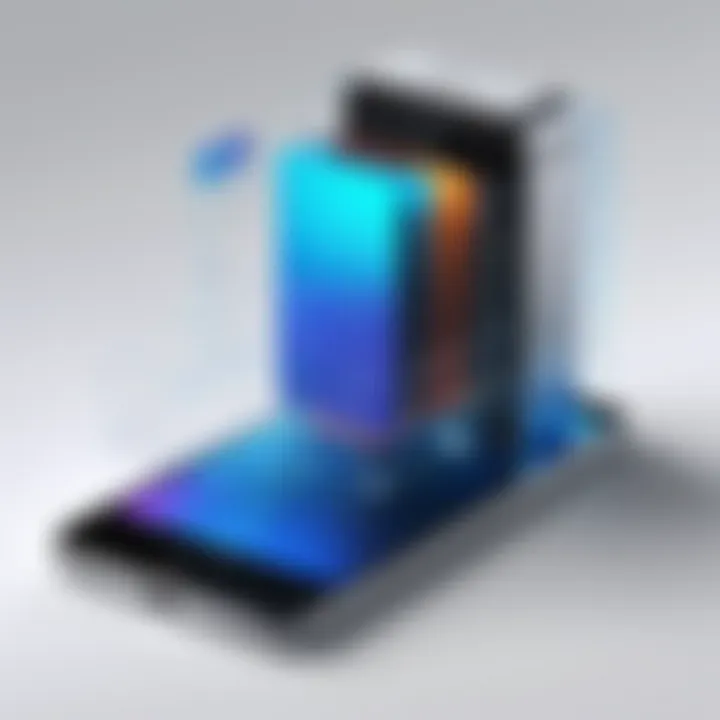Master iPhone Storage: Effective Optimization Strategies


Intro
Managing storage on an iPhone is not just a routine task; it is essential for maintaining efficiency and performance. As a consumer technology product, the iPhone is a sophisticated device that houses various applications, media, and data. The seamless operation of an iPhone largely depends on proper storage management. Elements such as photographs, apps, and system files can quickly eat up storage space, leading to potential slowdowns.
Product Overview
The iPhone is a powerful tool designed with advanced technology. It's not just a phone; it's a multifunctional gadget that serves as a personal assistant, entertainment device, and communication hub. From the latest iPhone 15 to previous models, all have unique features that impact storage needs.
Key Features and Specifications
- Storage options: iPhones come with various storage capacities, ranging from 64GB to 1TB. Higher storage means more apps and better performance, but it comes with a higher price.
- iCloud integration: This feature allows users to store files securely online, thus freeing up onboard storage.
- File management: iOS provides built-in tools to help monitor and manage storage efficiently.
- App Offloading: This feature enables users to remove apps while preserving their data for possible future reinstallation.
The understanding of these features is integral to creating effective strategies for storage optimization.
Performance and User Experience
One of the first things that users notice with storage issues is the performance of their iPhone. When storage gets low, the device can become sluggish. The user interface becomes less responsive, which can be frustrating. An efficient storage management strategy can lead to noticeable improvements in performance.
In hands-on testing, various third-party applications like CleanMyPhone and PhoneClean were evaluated. These applications often have intuitive interfaces, allowing for easy navigation and management of files.
User Interface and Ease of Use
User interfaces of these applications are generally straightforward. Most offer a dashboard highlighting at-a-glance information about storage usage. Users can see which categories consume the most space and quickly take action.
Comparison with Similar Products
While the App Store has multiple storage management options, comparison indicates that a few stand out for their functionality and user satisfaction. Alternatives like Gemini Photos specifically target photo management, making it easy to clear duplicates and similar images. Understanding these options can help users make the best choice based on their needs.
Design and Build Quality
The iPhone itself is designed with quality materials. The build uses glass and aluminum which offers a premium feel. However, the design does not directly influence storage, understanding ergonomic aspects can enhance overall user interaction.
Detailed Analysis of Design Elements
- Ergonomics: The shape of the iPhone allows for comfortable one-handed use, making it easy to navigate settings and file management tools.
- Durability: With its tough glass and aluminum body, the iPhone is built to last. Users should be conscious of how they handle storage and data to maintain device longevity.
Technology and Innovation
Apple has been at the forefront of technology and innovation with the iPhone products. Notably, integration of AI in managing files helps users understand how to optimize storage efficiently.
Groundbreaking Technology
- Machine Learning: The predictive capabilities in storage management help suggest apps that could be offloaded based on usage patterns.
- Optimization Features: Continuous updates enhance the ability of iOS to manage storage through automated prompts for cleaning up or managing large files.
Pricing and Value Proposition
In terms of value, an iPhone is often considered a premium product. Higher initial pricing is needed for models with more storage. However, the efficiencies gained through better storage management can yield long-term benefits.
Pricing Details
Investing in additional storage options like iCloud can be worth it for users who heavily utilize cloud-based features.
- iCloud pricing: Starts at around $0.99 for 50GB, which is modest compared to the potential value in free storage.
Recommendations and Final Verdict
While managing storage on an iPhone may seem daunting, with effective strategies and knowledge of tools, users can achieve a well-functioning device. By utilizing system features and third-party applications judiciously, iPhone owners can keep their devices running smoothly while enhancing their overall user experience.
"Storage optimization is not just about clearing space but understanding how best to use your iPhone’s capabilities."
Understanding iPhone Storage
Managing storage on an iPhone is fundamental for maintaining its performance and functionality. The space available directly affects the device's ability to run applications, store data, and function optimally. Therefore, understanding iPhone storage is not just about monitoring space; it's about grasping how the storage system works, what consumes space, and what can be done to manage it effectively.
Within this section, we will examine three crucial aspects of iPhone storage: its capacity, how the storage is utilized, and the inherent limitations that can hinder overall user experience. Proper acquaintance with these topics can lead to informed decisions on how to enhance device performance and avoid frustration associated with running out of space.
Storage Capacity Explained
The storage capacity of an iPhone is the total amount of space available for apps, media, and system files. iPhone models come in different storage configurations, typically ranging from 64GB to 512GB or more. Knowing your model's capacity helps in understanding how much content can be stored and gives a clear visualization of the usable space.
When users choose their iPhones, this capacity is a primary consideration. However, it is essential to recognize that what a user perceives as available space is often less than the listed capacity due to system files, pre-installed applications, and reserved space for iOS updates. Thus, if one selects a 128GB iPhone, they may only effectively use around 115GB or less after accounting for these factors.


Storage Usage Breakdown
To effectively manage iPhone storage, it is crucial to understand how storage is allocated across different types of data. This can be broken down into several categories:
- Apps: These often occupy a significant portion of the storage due to the size of the apps and the data they generate. Popular applications such as games, social media, or streaming services can especially be storage-heavy.
- Photos and Videos: Captured media can consume large storage quickly. High-resolution photos and 4K videos can take considerable space, especially for users who frequently document their lives.
- Messages and Attachments: Texts and media attachments in iMessage or other messaging platforms can accumulate over time, contributing further to storage use.
- Documents and Data: Files from apps like Notes, PDF readers, and document editors can also take up space, albeit in smaller amounts compared to media.
Understanding this breakdown provides insight into which areas might require urgent attention for cleaning or managing resources more efficiently.
Recognizing Storage Limitations
Despite having extensive storage capabilities, every iPhone comes with inherent limitations that users must recognize. One major limitation is that applications often reserve additional storage for their caches and temporary files. As apps continue to update, they may require more space, leading to unexpected storage challenges.
Another key limitation is the absence of expandable storage options. Unlike some Android devices that support memory cards, iPhones do not allow for additional storage expansions. This makes efficient management a necessity rather than an option.
Users should also keep in mind that certain functionalities, such as software updates or installing new apps, can be interrupted if storage is inadequate. As a general guide, it is advisable to keep at least 10% of the total storage space free for smooth operation of the iPhone.
Moreover, operating under the constraints of limited storage can result in slower device performance. Thus, recognizing and addressing these limitations is vital for ensuring the longevity and efficiency of your iPhone.
Investigating Storage-Consuming Apps
In the context of optimizing iPhone storage, understanding how certain applications consume space is essential. Many users remain unaware of the significant amounts of space taken up by specific apps, often leading to storage issues. This section will elucidate the strategies for investigating storage-consuming apps, highlighting their direct impact on the overall performance of the device.
Identifying High-Storage Apps
The first step in optimizing storage is identifying which apps use the most space. Certain apps, particularly those rich in multimedia content like social media platforms and streaming services, can quickly become storage hogs. For example, games and apps like Instagram or Facebook often cache images and videos. Users may not realize how these caches accumulate over time. Checking storage consumption helps users locate these high-storage apps and can make a meaningful difference in effective storage management. To do this:
- Navigate to Settings > General > iPhone Storage.
- This menu provides a list of apps with their respective storage usage.
- Focus on those taking up unusually large amounts of space.
Using Settings to Check Usage
In managing storage, the built-in iOS settings offer a straightforward way to monitor app usage. This is crucial for anyone looking to streamline their device. Accessing the storage settings provides insight into not only the size of each app but also the storage used by app data. Users should evaluate the contents and see if there are any unnecessary accumulations. This process can help clarify where the majority of storage is consumed. Important steps include:
- Go to Settings and select General.
- Tap on iPhone Storage.
- Review the listings of apps and their storage consumption.
As users reflect on this data, they can gain clarity on which apps to target for deletion or offloading.
Evaluating App Necessity
Once the high-storage apps are identified and usage is assessed, users should evaluate the necessity of each app. Some apps may no longer serve a purpose, while others might be kept because they are essential for daily activities. It is prudent to discern which applications truly add value. To do this efficiently:
- Ask questions regarding each app such as:
- When was the last time it was used?
- Is there a more efficient alternative available?
- Can its functionality be replaced by a different service?
This evaluation can help prioritize which apps should remain on the device and which can be safely removed, leading to optimized storage and improved device performance.
"Knowing what takes up your storage is half the battle to managing it effectively."
In summary, investigating storage-consuming apps is a proactive approach that leads to significant storage optimization. By identifying high-storage apps, using iOS settings to check usage, and evaluating app necessity, users can maintain a cleaner, more efficient iPhone. This method not only enhances storage management but also contributes to the overall performance of the device.
Optimizing Photos and Videos
Photos and videos often consume a large portion of the storage on an iPhone. These media files are essential for preserving memories and sharing experiences. However, their tendency to accumulate over time can lead to significant storage issues. Therefore, optimizing these files is a key component of maintaining a well-functioning device. Not only does this process help free up space but it also ensures that your device operates efficiently. By managing media effectively, you enhance your overall experience with the iPhone.
Reviewing Camera Settings
A simple yet impactful way to optimize storage is through camera settings. The way you take photos can influence how much space they occupy. For example, the option to shoot in 4K resolution provides impressive quality, but at the expense of storage capacity. If you do not require high-resolution footage for everyday use, consider adjusting the video recording settings to 1080p.
Additionally, the photo format matters. The High Efficiency Image Format (HEIF) is a modern standard that takes up less space compared to the traditional JPEG format. Switching to HEIF can yield significant storage savings without compromising image quality. Review your settings regularly to ensure they align with your usage needs. Making these adjustments is a straightforward yet effective strategy to ensure you do not waste precious storage space on your iPhone.
Clearing Unused Media
Over time, it is common for a large footprint of unused media files to build up on one’s device. This accumulation can include video clips you no longer need, photos that have been duplicated, or old screenshots. Taking time to regularly clear out this unused media is essential for effective storage management.
To facilitate this process, consider utilizing the 'Photos' app's built-in features, such as 'Recently Deleted' albums where files linger for 30 days before permanent deletion. This allows you to review if you truly want to recover them. Periodically go through your albums and delete any files that have no sentimental value or purpose. Creating a habit of clearing unused media will help in maintaining your iPhone’s performance and storage efficiency.
Utilizing Cloud Storage Solutions
Cloud storage solutions present a robust option for optimizing storage on your iPhone. They allow you to back up your photos and videos without overloading your device. Services like iCloud, Google Photos, or Dropbox offer excellent logic for maintaining your media files off-device. With these solutions, you can easily store vast amounts of data without impacting local storage.
By enabling options like 'Optimize Storage' in the Photos settings, you can save full-resolution images in the cloud while saving device space with compressed versions. Moreover, accessing old memories becomes more manageable, as many of these services provide tagging and searching features.


Managing Messages and Attachments
Managing messages and their attachments is a crucial step in optimizing your iPhone’s storage. Messages can accumulate over time, taking up significant space with photos, videos, and other data. This section will explore how to effectively manage messages and their attachments to regain valuable storage.
Deleting Old Conversations
Many iPhone users often overlook the storage occupied by old message conversations. Text messages, especially those containing media attachments, can consume more space than anticipated. Regularly deleting old conversations helps maintain a tidy storage environment.
- Selective Deletion: Navigate to the Messages app and swipe left on conversations that are no longer needed. This quick action removes the entire thread.
- Bulk Delete: If you want to delete multiple conversations, consider going into Settings, choosing Messages, and then tapping on 'Keep Messages' to adjust the retention settings. A shorter retention period means that messages automatically delete after a set time.
Taking time to delete older conversations allows you to clear out unnecessary files.
Evaluating Media within Messages
Another significant area to address is the media stored within messages. Attachments can take up substantial space. Evaluating the media periodically helps identify what can be removed or saved externally. Here’s how to do it:
- Review Attachments: Open a conversation and scroll to see media received. Tap on the person’s name at the top to see the ‘Info’ option where you can view all attachments in one place.
- Separate Important Media: Forward important images or videos to cloud storage or email rather than keeping them in the Messages app. This ensures that you do not lose valuable content while still reclaiming storage.
Adjusting Message Settings
Adjusting message settings can significantly impact how much storage is used on your iPhone. Here are some suggestions:
- Media Quality Settings: Go to Settings > Messages, where you can limit the quality of media sent over iMessage. Lower quality means smaller file sizes and less storage consumption.
- Disable Automatic Downloads: In the same settings menu, you can disable the automatic download of media. This can help you control what gets saved and when.
Effective management of messages and attachments can free up considerable storage on your iPhone. It is advisable to regularly review messages and make necessary adjustments to settings.
Assessing Downloads and Browser Data
Assessing downloads and browser data is vital in the context of optimizing iPhone storage. Many users accumulate numerous files and data unintentionally, leading to storage depletion. Recognizing what exists in these areas helps you reclaim valuable space. This process not only improves storage availability but also enhances the performance of your device. It can reduce lag and increase responsiveness, which is crucial for users who rely heavily on their iPhones for both personal and professional tasks.
Reviewing Downloaded Files
It is essential to regularly review downloaded files on your iPhone. Many users download files like documents, images, or videos that may no longer be needed. These files can consume significant storage space. Begin by navigating to the Files app, where you can find all downloaded content. Check folders labeled 'Downloads' or any other relevant directories.
Pay attention to file sizes and last modified dates. If a file hasn’t been accessed in months, it may be safe to delete. Consider creating a system for organizing essential files and regularly reviewing their importance. This practice can prevent unnecessary data build-up in the future.
Clearing Browser Cache
Clearing browser cache is a necessary action for maintaining optimal iPhone storage. The cache can include saved data from websites, which accumulates over time. When left unchecked, this can take up considerable space. To clear your cache, go to Settings, scroll to Safari (or your preferred browser), and select the option to clear history and website data. This action not only frees up storage but can also improve browsing speed, as it removes outdated or unused data.
Each browser may have slightly different steps for clearing cache, so it is beneficial to familiarize yourself with your most-used browser’s settings. Consistently managing this aspect of your storage can lead to a smoother and more efficient internet experience.
Managing Offline Content
Managing offline content is another significant factor in assessing downloads and browser data. Many apps, like Spotify or Netflix, allow for offline access to media files. Over time, downloaded songs and videos can aggregate and occupy large amounts of space. To manage this content, delve into the settings of each application to see which files can be removed or streamed instead of downloaded.
Consider implementing a routine for evaluating offline content. Set a reminder to check these settings every few weeks. This proactive approach can help you keep your storage in control while still enjoying the benefits of offline media access. If you do not listen or watch specific content frequently, deleting it can markedly free up storage.
"An effective approach to storage management entails not just deleting files but also being mindful of what is necessary for daily use."
Exploring Third-Party Storage Management Apps
Managing storage on an iPhone is not just about using built-in features effectively; utilizing third-party storage management apps can significantly enhance your ability to reclaim space. These applications offer various functionalities tailored to help users identify and mitigate storage issues. The significance of exploring third-party options lies in their capacity to provide advanced management tools that may not be available within iOS. By integrating such apps into your routine, you can achieve a more thorough understanding and management of your iPhone's storage system.
Identifying Trustworthy Applications
When considering third-party storage management applications, it is crucial to identify those that are reliable and secure. First, look for apps that are highly rated in the App Store. Popular choices often include Gemini Photos, Cleaner Pro, and Smart Cleaner. Furthermore, ensure that the app has a transparent privacy policy. This helps in understanding how your data will be managed and protected. Another aspect to look for is regular updates from developers. This indicates that the application is actively maintained and keeps up with the latest iOS changes, addressing potential bugs and security vulnerabilities.
Comparing Features and Functionality
Once you have identified trustworthy applications, the next step is to compare their features and functionality. Many third-party storage management apps provide tools for analyzing storage usage, removing duplicates, and clearing cache files. For example, Gemini Photos specializes in detecting similar photos, making it easy to delete duplicates in a few simple taps. Additionally, examine whether the apps offer cloud integration, as this can complement iPhone storage strategies by seamlessly allowing file transfers. It is advisable to review the specific functionalities each app offers to select the one that fits best with your storage management needs.
Considering User Reviews and Ratings
User feedback is invaluable when assessing third-party storage management applications. Spend some time reading reviews and ratings in the App Store. Look for comments related to ease of use, effectiveness, and customer support. For example, an app receiving consistent praise may indicate strong performance, while a pattern of negative comments can suggest underlying issues. Sites like Reddit are also good resources for unbiased opinions and real-world experiences shared by users. This allows you to make a well-informed decision based on the collective experience of others what applications deliver on their promises and which do not.
"When looking for an app, always prioritize security and functionality based on user experience. Your storage data integrity depends on it."
By evaluating trustworthy applications, comparing features, and leaning on user reviews, you enhance your capability to optimize iPhone storage effectively through third-party resources.
Utilizing Built-In iOS Features


Utilizing the built-in features of iOS is essential for managing your iPhone storage effectively. Apple has equipped its operating system with various tools that assist users in maintaining a clean and efficient device. These features are designed to maximize storage, improve usability, and enhance overall device performance.
Accessing iPhone Storage Settings
The first step in optimizing iPhone storage is to navigate to the Storage settings. This can be located by going to Settings > General > iPhone Storage. Here, a comprehensive overview of your storage usage is displayed. You will find insights into how much space is used and how much is available. Each app is listed along with the amount of storage it consumes. This information is critical in identifying which apps take up the most space. In addition, iOS provides recommendations for optimizing storage at the top of this section.
Implementing Recommendations
After reviewing storage settings, implementing recommendations becomes the next logical step. iOS generates tailored suggestions based on your current storage status. These might include options like deleting large attachments in messages, reviewing downloaded items, or offloading unused apps. By following these recommendations, users can swiftly reclaim valuable storage space. It can be helpful to periodically revisit these suggestions as the storage landscape changes over time, particularly after substantial downloads or app usage.
Exploring Offloading Unused Apps
Offloading unused apps is another significant feature available in iOS. This option can be especially beneficial for users who download applications frequently but do not use all of them regularly. When an app is offloaded, the app itself is removed, but its data remains on the device. If you decide to reinstall the app later, all documents and data are intact. To enable this feature, head to Settings > App Store > toggle on Offload Unused Apps. This automatic process helps maintain optimal storage without requiring continuous manual management.
This method is useful for managing the limited storage capacity of iPhones, especially on models with smaller built-in storage.
Establishing a Regular Maintenance Routine
Maintaining an organized storage system on an iPhone is essential for optimal performance and functionality. Regular maintenance helps prevent issues related to storage limitations, especially as the device collects various media and downloaded items over time. Establishing a routine makes sure that unnecessary files are cleared, ensuring smoother operation of applications and improved overall device speed.
Creating a Cleaning Schedule
Having a cleaning schedule is critical for effective storage management. Ideally, the schedule should be set based on personal usage patterns. For instance, if you frequently download media or apps, aim to assess your storage every month. During each cleaning session, you can focus on identifying and deleting items that no longer have value.
Some aspects to consider include:
- Frequency: Monthly checks for high-usage periods and more often if needed.
- Types of files: Photos, videos, apps, and documents should be reviewed.
- Methods of cleaning: Whether automated features will be used or manual deletion.
Regular cleaning alerts your system to regenerate space, allowing potentially critical updates to be installed without a hassle.
Setting Storage Alerts
Setting up storage alerts proves valuable in managing space proactively. Most iPhones offer settings to notify users when storage drops below a specified level. This can help prevent running out of space unexpectedly, which can affect performance and functionalities.
To set alerts, follow these steps:
- Go to Settings.
- Tap on General and select iPhone Storage.
- Review potential alerts available.
You can also choose third-party apps that are specialized in sending you reminders based on your usage. Alerts can cover thresholds such as:
- 10% or less available storage
- When certain apps are consuming excessive space
Documenting Storage Changes
Documentation is an often-overlooked part of the storage maintenance routine. By keeping track, you can recognize patterns in storage usage, which helps streamline future cleaning sessions.
Consider maintaining a simple log with details such as:
- Date of cleaning
- Space cleared (in GB)
- Types of files removed
- Notable trends (like sudden increases in storage consumption by specific apps)
Such documentation allows for reflection on storage habits. With time, you will better understand your usage, and it becomes easier to adapt cleaning habits accordingly.
Regular maintenance is not just about the immediate benefits. It builds a habit that significantly enhances your iPhone's longevity and performance.
Refining Your iPhone Experience
In any digital ecosystem, enhancing the device user experience relies significantly on storage management. This is especially true for the iPhone, where users often encounter limited storage capacities that require efficient optimization strategies. Refining your iPhone experience involves not merely freeing up space but leveraging that space to ensure the device operates at its fullest potential. Understanding the layers of this concept allows users to navigate through their devices more smoothly and supports better functionality.
Benefits of Storage Management
Storage management yields a number of advantages that extend beyond mere space availability. Firstly, it improves device speed. When storage is optimized, the operating system can access files faster, leading to quicker app launches and smoother performance. Additionally, managing storage helps in prolonging the lifespan of your iPhone; as the device operates more efficiently, it reduces wear and tear on hardware.
Moreover, having a well-organized storage system enhances usability. It allows users to locate files with ease, minimizing frustration caused by cluttered apps or media libraries. Finally, regular maintenance fosters a mindset of digital hygiene, encouraging users to routinely check and refresh what is held on their devices.
Enhancing Overall Device Performance
Improving overall device performance is often a top priority for iPhone users. Storage is a fundamental factor here. Each app, photo, or video occupies space. When this space is scarce, the system must work harder to manage running apps and background processes. By purging unnecessary files and optimizing settings, users can achieve a more responsive interface. This directly correlates with benefits such as a decrease in lag time and improved multitasking capabilities.
High storage usage can lead to several issues, including slower application response times and unexpected crashes. When users actively manage their storage with tools like Apple's Diagnostics, they can monitor how apps affect performance and identify issues that may hinder their experience.
Future-Proofing Your Technology Use
As technology continues to evolve rapidly, future-proofing is a pivotal consideration for modern iPhone users. This concept entails preparing for coming advancements that may require more storage or processing capacity. By implementing effective storage management now, users can mitigate future problems that arise from newer operating systems or more intensive applications.
For example, adopting cloud solutions like iCloud for file storage enables users to keep local storage needs minimal while ensuring important data is easily accessible. Similarly, learning about storage management practices today equips users with the knowledge to adapt as new technologies emerge. With proactive measures, iPhone users can maintain relevant usability without being bogged down by their device’s storage limitations.
"Optimizing storage not only enhances immediate performance but also secures the device for future advancements."



